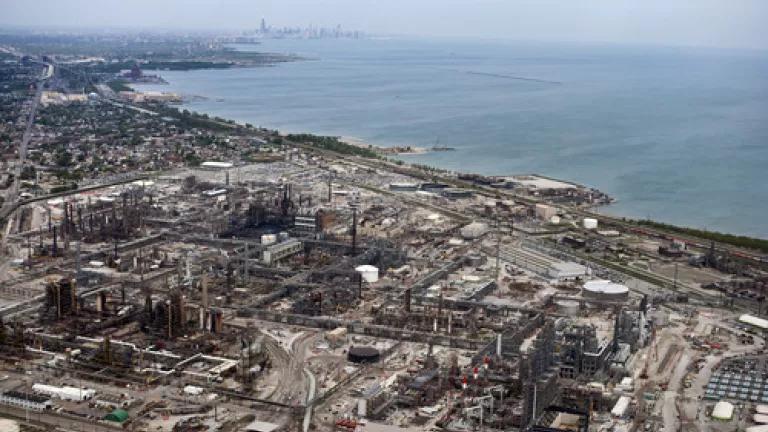
The Indiana Department of Environmental Management today issued the final version of the water discharge permit for BP’s Whiting refinery, the draft of which had inadequately addressed the refinery’s mercury discharge to Lake Michigan.
Viewed in light of the contentious history of IDEM’s permits for the refinery’s tar sands expansion – the last of which culminated in an NRDC lawsuit and a $400 million settlement – the new permit is somewhat of a pleasant surprise, albeit still a mixed bag. While IDEM did not do everything we asked, it adopted some of our key requests, and made modest but significant changes. Overall, the language of the agency’s response to our comments reflects a newfound spirit of willingness to take our input seriously.
Our chief concern with the draft permit was that it did almost nothing to incorporate the results of the promising mercury control technology research performed by Argonne National Laboratory. Argonne had conducted pilot tests demonstrating that one technology in particular, ultrafiltration, could consistently meet the very stringent mercury standard applicable to the Great Lakes (1.3 parts per trillion). Rather than incorporating a requirement to conduct the few remaining research steps that Argonne had specifically identified, the permit contained only general language requiring BP to continue studying the problem – creating a risk that the company would study it to death without ever taking action. We pointed out that this lack of a mandate for prompt action was particularly concerning given that IDEM had earlier given BP a variance affording a legal-go-ahead to dump close to 20 times more mercury than the Great Lakes limit (23.1 parts per trillion).
In its response to our comments, IDEM concurred with us that “The permit must make clear that BP cannot be allowed to indefinitely study the problem if technology is available to reduce its mercury discharge,” and that “the language describing the next phase of pilot testing should incorporate the specific recommendations from the Argonne research.” Accordingly, the final permit adds extensive language describing precisely how BP must go about the concluding steps of the ultrafiltration research, and requires that the company submit a report to IDEM no later than March, 2015. IDEM said in its response to comments that it believes the level of detail now required in the report will provide it a basis to determine whether the ultrafiltration technology is “available and economically viable.” Additionally, the permit brings down the variance-based mercury limit from 23.1 to 8.75 parts per trillion, based on monitoring of the refinery’s effluent showing that mercury concentrations never came close to the higher limit.
These are all positive steps. Unfortunately, they do not address the larger problem of the crazy system that allowed the soaringly high variance-based limit in the first place. As we and the Chicago Tribune explained previously, Indiana’s “streamlined mercury variance” program (always beware of anything that environmental agencies call “streamlined”) is a polluter’s happy dream, allowing IDEM to identify the highest mercury hit in two years of monitoring and then use that peak number as the permitted annual average -- meaning that discharges could be even higher than that highest hit as long as it all averages out. It’s nice that BP’s discharge limit has now been reduced to something that more closely reflects its actual maximum mercury discharge rather than the outlier hit incorporated in its previous permit. But it’s still rather ridiculous that the permit makes BP’s very worst performance into an average. That is beyond the scope of this permit, but it is something that the State of Indiana must address for the health and well-being of Hoosiers and those of us in neighboring states impacted by the potential for wholesale dumping of toxins into the source of drinking water for millions.
IDEM made a couple other positive changes in response to our comments as well. In response to our concern that that public would not have access to the stormwater pollution prevention plan that BP is required to prepare and update, IDEM is now requiring that the plan be submitted to it – as opposed to held onsite at BP, as the draft permit had required. This will allow interested members of the public to obtain the plan via a public records act request. Additionally, while IDEM did not respond to all of our concerns with the draft permit’s woefully inadequate analysis of the refinery’s cooling water intake system – which can cause extensive damage to aquatic life that is sucked into it – the final permit adds some additional requirements that BP analyze the functioning and impact of the system.
While we remain deeply concerned that the tar sands expansion at the Whiting refinery has happened at all, these small steps in the right direction by IDEM afford some cautious optimism that environmental regulators can be brought around to recognize that stringent controls on pollution from refining tar sands crude are imperative. We can hold out hope that IDEM’s more cooperative tone reflects the shape of things to come.
Image © J Henry Fair 2013, www.IndustrialScars.com / Flight provided by LightHawk, www.LightHawk.org

